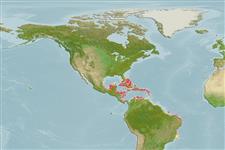Classification / Names
Common names from other countries
Main reference
Size / Weight / Age
Max length : 2.5 cm TL male/unsexed; (Ref. 5521)
Environment
Marine; reef-associated; depth range 1 - 8 m (Ref. 51183)
Climate / Range
Tropical, preferred ?
Distribution
Short description
Dorsal
spines
(total): 18 - 19;
Dorsal
soft rays
(total): 7-8;
Anal
soft rays: 15 - 16;
Vertebrae: 31 - 33. Dark blotches on trunk often arranged in 2 or 3 horizontal tiers; pale gap between 2 blotches of darker pigment on pectoral-fin base with wavy margins; cheek with irregular horseshoe-shaped blotch of pigment; no streak of dark pigment along distal edge of preopercle.
IUCN Red List Status (Ref. 115185)
Threat to humans
Harmless
Human uses
More information
Common namesSynonymsMetabolismPredatorsEcotoxicologyReproductionMaturitySpawningFecundityEggsEgg development
Age/SizeGrowthLength-weightLength-lengthLength-frequenciesMorphometricsMorphologyLarvaeLarval dynamicsRecruitmentAbundance
ReferencesAquacultureAquaculture profileStrainsGeneticsAllele frequenciesHeritabilityDiseasesProcessingMass conversion
Tools
Special reports
Download XML
Internet sources
Estimates of some properties based on models
Phylogenetic diversity index
PD50 = 0.5000 many relatives (e.g. carps) 0.5 - 2.0 few relatives (e.g. lungfishes)
Trophic Level
3.1 ±0.4 se; Based on size and trophs of closest relatives
Resilience
High, minimum population doubling time less than 15 months ()
Vulnerability
Low vulnerability (10 of 100)
Price category
